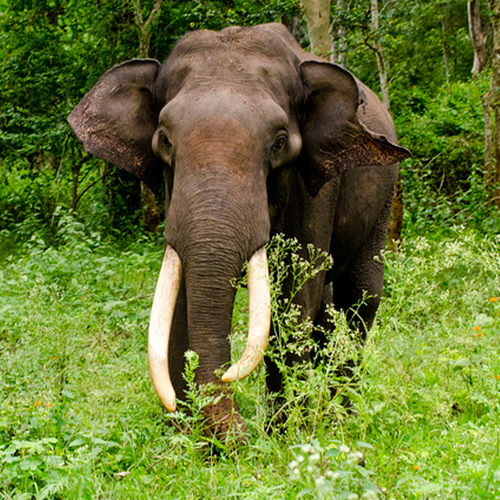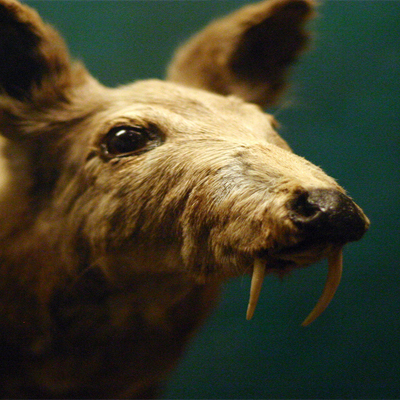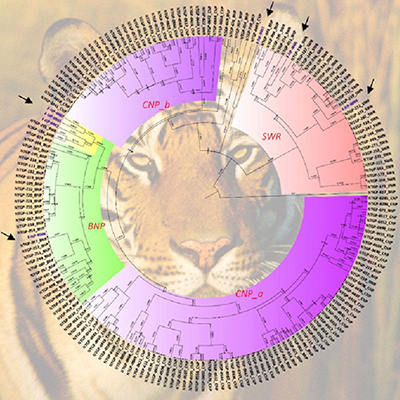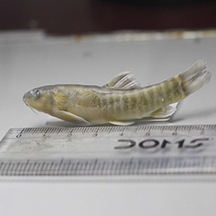Wildlife Conservation
We have conducted numerous studies on some of the world’s most endangered animals. Utilizing our current capacity and know how, we have introduced conservation genetics in research studies of such animals as snow leopard, musk deer, wolf and Asian elephants. Through our Nepal Tiger Genome Project, we are building a comprehensive DNA database of all the Bengal tigers found throughout Terai arc region of Nepal. We have also been working on developing molecular diagnostic tools for the detection of Tuberculosis and Herpes in Asian Elephants. Additionally, we are working on population census studies of the Asiatic one-horned rhino in Chitwan and common leopards in the Annapurna area and conducting ex-situ conservation of threatened species such as Vultures and Amphibians

Developing Highly Effective and Thermo-t...
Threats of various known and unknown poultry diseases are amongst the biggest challenges faced by the commercial and domestic poultry sector. Newcastle disease is considered to be among the deadliest ...
Read More
Predict Jadibuti Map
Predict JadibutiMap, the first of its kind, offers a comprehensive overview of the household survey integrating animal virus sampling results performed on ducks and rats at the Jadibuti area of Kathma...
Read More
Bat Telemetry Tracking Map
A Bat Telemetry TrackingMap has been prepared to showcase the bat tracking activity at Sillinge, Nepal. The species tracked was RousetusLeschenaultii using telemetry at around 40 locations. The map sh...
Read More
Usage of Bioinformatics to Infer Hidden ...
Bioinformatics has become an essential tool for analyzing and interpreting biological and genetic data. Bioinformatics utilizes computational systems and software to combine statistics, mathematics an...
Read More
Genetic Species Characterization of Amph...
This study focuses on understanding the biodiversity of amphibians in Nepal and the underlying mechanisms that have driven diversification within these species. Based on morphology and the genetic wor...
Read More
Pika, Ochotona spp.
Pika (Ochotonaspp) is a small, herbivorous,conspicuously cute mammal related to rabbits and hares. There are 30 speciesof pikas (Ochotona spp.) distributed throughout the world. Five species of Pika s...
Read More
Himalayan field Mouse, Apodemusgurkha
Himalayan field mouse is a nocturnal andterrestrial species. This species is endemicto Nepal and is known only to be foundfrom seven locations (Gurkha, Maharigaon,Gorapani, Takucha, Larjung, Chitare a...
Read More
Cuonalpinus (Dhole) - Genetics based pop...
Dhole, commonly known as the Asiatic wilddog is a much understudied species with a lowfragmented population distributed across partsof South/South East Asia. Now a protectedspecies, the Dhole is in da...
Read More
Wildlife forensic regional capacity buil...
Wildlife crime is a serioustransnational threat tobiodiversity in South Asia.Driven by organized criminalsyndicates who control theburgeoning and highly lucrative illicit trade, it is impossible foran...
Read More
Preliminary assessment on use of Fragmen...
Duchenne Muscular Dystrophy (DMD) is arecessive X-linked form of muscular dystrophy,affecting around 1 in 3,600 boys, which results inmuscle degeneration and eventual death.
Read More
Wildlife research usinginnovative techno...
CMDN has been actively developing and testing variouscutting edge technologies to capture, transmit and analyzewildlife information. CMDN has been experimenting withvarious unmanned aerial .....
Read More
Human wildlife disease risk assessment i...
More than 60% of infectious diseases in humansare caused by pathogens shared with wild ordomestic animals (Taylor 2001), and the greatestburden on human health and livelihoods globallyhas been linked ...
Read More
Virus discovery in wildlife-urban interf...
The USAID Emerging Pandemic Threats PREDICTproject has been working withgovernment partnersin 20 countries to develop efforts for surveillance,testing, and reporting of potential human pathogensin wil...
Read More
Species identification using DNA Bar-cod...
As part of biodiversity research, CMDN has beencollaborating with the Griffith University (Australia) toidentify species using DNA analysis on various biologicalsamples collected from long term biodiv...
Read More
Surveillance of Influenza A and its sub-...
Wild migratory birds whose migratory path often crisscross south and east Asian countries, are known to carry the highly pathogenic avian influenza (HPAI). This study is designed to detect and charact...
Read More
Population census of the One-Horned Rhin...
The range of Rhino are now confined to few scattered places in Terai Arc Landscape of India and Nepal and in the grasslands of Assam, north Bengal and northeast India. In this currently-on going study...
Read More
Assessment of detection technique for M....
Elephant are prone to a variety of infectious disease including tuberculosis, which pose a significant risk to the future conservation of captive and wild Asian elephant populations. Tuberculosis is w...
Read More
Prevalence of Elephant Endotheliotropic ...
Elephant endotheliotropic herpesvirus (EEHV) is a growing threat to the Asian elephant population worldwide. The disease is characterized by sudden onset of lethargy...
Read More
Musk Deer in Mustang, Nepal
There are three different musk deer species said to exist in Nepal, Moschus chrysogaster, Moschus leucogaster, and Moschus fuscus, although their exact distribution is unclear and yet to be validated ...
Read More
Non-invasive genetic population survey o...
CMDN, together with WWF-Nepal, the Department of National Parks and Wildlife Conservation and Snow Leopard Conservancy, conducted .....
Read More
Molecular based Wildlife Forensics: Gene...
The baseline genetic database generated through the Nepal Tiger Genome Project (NTGP) has built an effective tool in the fight against wildlife crime in Nepal and beyond. Seized wildlife parts have be...
Read MoreGenetics of Trans-Himalayan Wolf (Canis ...
Himalayan Wolf is a sub-species of the Gray Wolf- a fairly new species. They are mostly found in India (Jammu, Kashmir) and Nepal with some reported presence in China and Mongolia. There is limited in...
Read More
Genetic species characterization of rode...
Many members of the Rattus species have sub-species with various color patterns and they globally distributed. Many Rattus sub-species are believed to be native to India and other Indo-Malayan countri...
Read More
Genetic Study of Bengal tigers
Nepal Tiger Genome Project
Consider yourself fortunate if you spot a tiger deep in jungle- an incredible thrill only few lucky ones get to experience. Sadly, there aren’t many of these beautiful beasts left in the wild!!! ...
Read More
Wildlife Genetics and Conservation: The ...
Wildlife genetics constitute one of the core research activities at CMDN. As pioneers of non-invasive genetics in Nepal, we have so far studied felids (Tiger, Snow Leopard, Common Leopard, Pallas Cat)...
Read More
Environmental DNA Meta-Barcoding of fish...
Knowledge on species distribution and ecology is critical for ecological management and conservation biology. Information on distribution of native fish in Nepalese rivers is limited; there is a pauci...
Read More
Tiger/Snow Leopard Diet Analysis
DNA based diet analysis using high throughput sequencing provides us with high grade information of the prey species and other remaining from the feacal matter...
Read More
Tiger Fecal Virology
Fecal sample is the great source and approach for studying viral metagenomics associated with the host and related zoonotic disease. Virus communities in the feaces of the tiger will help us expand th...
Read More